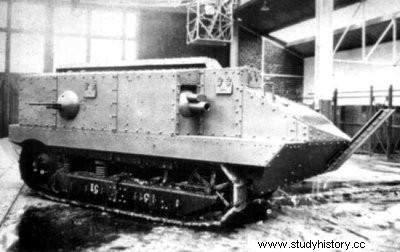General features

Crew 6
Length 6.32m
Width 2.05m
Height 2.30m
Combat mass 14.6 tons
Armor and armament
11.5mm armour
Main armament 75 mm gun (90 shells, range:600 m, accurate to 200 m)
Secondary armament 2 Hotchkiss 8 mm machine guns (one on each flank)
Mobility
Schneider 4-cylinder engine
60 hp (45 kW)
Road speed 7.5 km/h
Autonomy 48 km
In late 1914, the French Army inquired about a means of countering the machine guns and barbed wire of trench warfare, which would additionally allow relatively safe movement over rutted ground from shelling. 'artillery. In January 1915, the company Schneider et cie began work on a new military machine dedicated to this task.
Invented by Eugène Brillié, the prototype of this tank was presented on June 16, 1915 to the President of the French Republic, Raymond Poincaré. The demonstration having convinced this one, ten units are ordered. Later, this number will increase to 400 units.
The development of a first prototype, tractor A, will be done with the company Saint Chamond. But after differences, each company will develop its own machine:the CA1 for Schneider, and the Char Saint Chamond for Saint Chamond.
The first Schneider tanks were delivered in September 1916. Built for a crew of one driver and five crew, the tank was equipped with a 75mm gun mounted at the front right and two side Hotchkiss machine guns, protected by shields hemispherical. The bow shape of the front of the machine made it possible to shear barbed wire thanks to the steel rail it carried, as well as to avoid turning over when crossing a trench.
The Schneider tank fought for the first time on April 16, 1917 at Berry-au-Bac, on the Chemin des Dames. It had poor performance and its poor ventilation capabilities along with the poor field of vision it offered the crew made it difficult to operate. In addition, its side armor was too weak (vulnerable to German steel-core "K" bullets) and its internal tanks made it very dangerous.
Despite the improvements undertaken, the French army decided to 'Abandon construction in favor of Renault FT-17 light tanks.
Schneider tanks nevertheless remained in service until the Armistice, escorting infantry and FT-17s.
